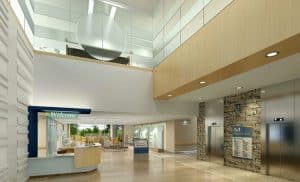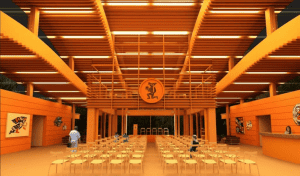From dusty archival corners both digital & analog, we retrieve a still-relevant noise control overview for architects, designers, builders, & others.

I stumbled upon the term “armchair acoustician” in a recent article explaining the differences between sound isolation and room acoustics. I’d long known that the former process minimizes sound transmission between rooms by incorporating mass into wall and ceiling/floor assemblies, while the latter optimizes sound qualities within a given room. Even so, the words “armchair acoustician” managed to leap from their page and smack me upside the ego. Although I suppose dilettante would’ve stung a little more. Anyway…
Some of you will know that I’ve always been forthcoming here about being neither an engineer nor an acoustician of any sort. And yet BAP Acoustics principals Mark Gaudet and Eric DeSantis keep paying me to write for them! Why?
I mean, what kinda geek rabbit-holes her way down all manner of research paths and processes just enough vital information to share with other non-experts? Well, a writerly geek, for starters. A geek who understands that architects and builders aren’t acoustical engineers either.
A geek who’s learned that making the right design or material choice at the right time often hinges on acoustical considerations. And that not addressing acoustical considerations at critical junctures can lead to costly remedial work post-build.
This is where an understanding of noise control fundamentals serves well. (As does engaging highly skilled acoustical consultants in the early stages of project planning and design.) So this geek figures, hey, sharing what knowledge she’s amassed in an accessible style could potentially help professionals make informed and cost-effective design choices.
Of geeky rabbit holes & refurbished source material
A Guide To Airborne, Impact, and Structure Borne Noise Control in Multi-family Dwellings is an excellent overview. It is 50 years old and has been ignored by architects for the same period of time.
—Robert Healey, Acoustical Consultant on ProSoundWeb forum
Three years ago, I’d been learning all about noise complaints and strata bylaws to write When common property use results in common noise complaints, a topic inspired by the story of a BAP Acoustics client whose condo building also housed a very noisy jacuzzi hot tub for resident use. I found much of what I needed to know in principal Eric DeSantis’s 2017 blog post The Canadian Building Code and Noise in Multi-Family Buildings. (Key takeaway: “building code” = code for “bare minimum requirement”)
Of course, being the rabbit-hole-diving geek I am, I wanted more. I was still learning pretty foundational stuff at that time, but also determined not to learn it all from other people’s blogs. This very determination led me to the gem I’m lovingly restoring now—chapter by somewhat-legible PDF chapter—so you don’t have to. (One day I may digitize my mama’s old cookbooks.)
As to the continued relevance of a 1967 industrial guidebook, I thank Robert Healey (quoted above) for his informed recommendation. Of course, physics is physics, so it comes as no great surprise that sound-related terminology hasn’t changed much.
But what I find exceptionally striking is how many of the authors’ key points are every bit as true today, if not in some instances more so. Of particular note, the US Federal Housing Administration of 1967 actually offered something called a Technical Studies Program…And partnered with the now-defunct National Bureau of Standards to address “the growing public demand” for noise control within buildings.
We know the need for noise control—not only in residential buildings, but across sectors—is still considerable. Maybe we also need to turn up the volume on our public demand?
Before reading further, please be aware that the following excerpts may well be older than you, so bear in mind that some of the language used is a little dated, pronoun-wise in particular. Thanks for understanding, female architect readers!

Excerpts from A Guide To Airborne, Impact, and Structure Borne Noise Control in Mufti-family Dwellings
Preface
Under the sponsorship of the Federal Housing Administration Technical Studies Program, the National Bureau of Standards has developed and prepared this Guide for the benefit of architects, designers, contractors, builders, and housing officials to assist them in meeting the growing public demand for control of the building noise problem, particularly in multifamily dwellings.
Surveys have established that the most common complaint among apartment dwellers where noise is involved in its transmission from one apartment to another within the building. Typical noise sources are television, radio, stereo, occupant activity, plumbing fixtures, electro-mechanical equipment, and household appliances. To minimize the annoying disturbance caused by these sources, architects must have a general knowledge of the principles of noise transmission and be able to apply proper design techniques in order to provide effective controls.
With these objectives in mind, this Guide incorporates a broad range of criteria appropriate for isolating airborne, impact, and structure-borne noise associated with residential construction. Sound classifications represented in the most common types of building construction are identified. Also included are summaries of a number of foreign codes now in existence.
This Guide incorporates previous impact noise research performed by Bolt Beranek and Newman and sponsored by FHA. The FHA Minimum Property Standards will reference this NBS Guide.
Terminology
The definitions of some terms used most frequently throughout this guide are assembled here for convenience.
ABSORBER, SOUND. A device, panel, or material specifically designed to absorb sound energy. Such devices are usually constructed of porous materials composed of organic or mineral fibres.
ACOUSTICAL DESIGN. A consideration of all factors bearing on the achievement of a desirable acoustical environment, including the selection of building sites, orientation of buildings, space arrangement within buildings, and proper selection and installation of wall and floor assemblies, building equipment and services.
ACOUSTICAL PRIVACY. The assurance that there is sufficient insulation from intruding and disturbing noises.
ACOUSTICAL TREATMENT. The application or use of any sound absorbers, building materials or structures and construction techniques for purposes of controlling noise and improving the acoustical environment.
AIRBORNE NOISE. Noise radiated initially into and transmitted through air.
AMBIENT NOISE. The quiet-state noise level in a room or space, which is a composite of sounds from many external sources both near and far, over which one individually has no control.
ATTENUATION, SOUND. The reduction of the energy or intensity of sound.
AUDIBLE SOUND. Sound which is capable of being heard.
BACKGROUND NOISE. The sound level present in a room or space at any given time above which speech, music, desired signal or sound must be raised in order to be heard or made intelligible.
BAFFLE OR BARRIER, SOUND. A shielding structure or partition used to increase the effective length of a sound transmission path between two locations. Such structures often are constructed or surfaced with sound-absorbing materials and are frequently used to seal open plenums above ceilings or below floors.
CAULK. An elastic non-setting material used for sealing cracks, seams and joints to prevent leakage of sound.
DECIBEL (dB). See “SOUND PRESSURE LEVEL”.
FLANKING TRANSMISSION. The transmission of sound or noise from one room to another by indirect paths, rather than directly through an intervening partition.
FLEXIBLE COUPLER. A device to prevent or reduce the transmission of vibration, particularly between vibrating equipment and service distribution systems involving ductwork, piping and electrical lines.
FREQUENCY, SOUND. The number of complete to-and-fro vibrations that a source of sound makes in one second. Frequency is measured in Hertz (cycles per second). The pitch of an audible sound depends mostly on its frequency.
IMPACT INSULATION CLASS (IIC). A single-figure rating which provides an estimate of the impact sound insulating performance of a floor or ceiling assembly.
IMPACT NOISE. The noise produced by the impinging or striking of one object with another, e.g. noise caused by footsteps.
INERTIA BLOCK. A massive support used in isolating equipment vibration. The block is usually much heavier than the equipment it supports.
MASKING. The presence of background noise increases the level to which a sound signal must be raised in order to be heard or distinguished. If the level of background noise is significantly higher than that of the sound signal, for instance, a sound transmitted from another room, the transmitted sound signal cannot be heard. This effect is known as masking.
NOISE. Unwanted sound.
PARTY WALL. A wall which separates two adjacent dwelling units within an apartment building.
RESILIENT MOUNTING. A mounting, suspension or attachment system which reduces or restricts the transmission of vibrational energy, e.g. between vibrating elements and building structures.
RESONANCE. The sympathetic vibration, resounding or ringing of enclosures, room surfaces, panels, etc. when excited at their natural frequencies.
REVERBERATION. The persistence of sound within a room or enclosure after a sound source has stopped radiating. This effect is very pronounced in large, relatively empty or partially furnished rooms with hard reflecting walls, ceilings and floor surfaces.
SHORT CIRCUIT. A bypassing connection or transmission path which tends to nullify or reduce the sound-insulating performance of a building construction or acoustical device.
SOUND. (1) The sensation of sound. (2) A branch of physics concerned with the propagation of mechanical disturbances in matter and related subjects. In the present context sound is originated by vibrating bodies or aerodynamically, is propagated as an elastic disturbance at least partly in the air, and arrives at the ear or other receiver (microphone, etc.).
SOUND INSULATION, ISOLATION. The use of building materials or constructions which will reduce or resist the transmission of sound.
SOUND LEAK. A hole, crack, or opening which permits the passage of sound.
SOUND PRESSURE. A fluctuation superimposed on the static atmospheric pressure by the passage of sound waves.
SOUND PRESSURE LEVEL (SPL). Expressed in decibels, the SPL is 20 times the logarithm to the base 10 of the ratio of the pressure of sound to the reference pressure 0.0002 dyne per square centimetre.
SOUND TRANSMISSION. The travel or propagation of sound into a room by any path, direct or indirect, from a sound source located outside the room.
SOUND TRANSMISSION CLASS (STC). A single-figure rating which provides an estimate of the airborne sound insulating performance of building partitions.
SOUND TRANSMISSION LOSS (STL). The decrease or attenuation in sound energy (expressed in decibels) of airborne sound as it passes through a building construction. In general, the transmission loss increases with frequency, i.e. the higher the frequency the greater the sound transmission loss.
STRUCTURE-BORNE SOUND. Sound energy imparted directly to and transmitted by solid materials, such as building structures.




